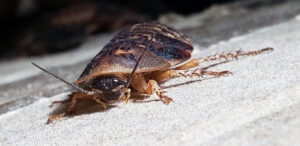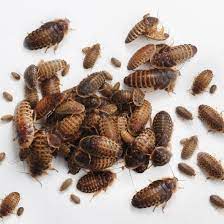Are Dubia Roaches Safe for Leopard Geckos?

Yes, Dubia roaches are completely safe for leopard geckos of all ages — from hatchlings to adults.
In fact, they’re one of the safest feeders you can provide. Here’s why:
-
🪳 Non-aggressive: Unlike crickets, Dubia roaches don’t bite or harass your gecko.
-
🪳 Soft-bodied: They have a relatively soft exoskeleton that makes them easy to digest.
-
🪳 No climbing or jumping: They stay grounded, reducing the chance of escapes or stress in the enclosure.
-
🪳 No smell or noise: Unlike crickets, they don’t chirp or stink up your reptile room.
For all these reasons, many keepers consider Dubia roaches not just safe — but ideal.
Nutritional Value of Dubia Roaches
Dubia roaches are incredibly nutrient-dense. Compared to other common feeder insects, they offer high protein, low fat, and excellent calcium-to-phosphorus ratios — all crucial for your gecko’s health.
📊 Nutritional Comparison Table (per 100g dry matter)
| Feeder Insect | Protein (%) | Fat (%) | Calcium (mg/kg) | Ca:P Ratio |
|---|---|---|---|---|
| Dubia Roaches | 60–65% | 6–7% | 700–800 | ~1.5:1 |
| Crickets | 55–60% | 12% | 300–400 | ~0.3:1 |
| Mealworms | 50% | 25% | 100 | ~0.1:1 |
| Superworms | 50% | 18% | 200 | ~0.1:1 |
As you can see, Dubia roaches beat out mealworms and crickets when it comes to calcium and fat content. This makes them particularly suitable for preventing metabolic bone disease — a common concern in leopard geckos.
Top Benefits of Feeding Dubia Roaches to Leopard Geckos
Still on the fence about using Dubia roaches? Here are the main reasons why keepers love them:
1. High Protein, Low Fat
Perfect for healthy muscle development and energy without making your gecko obese.
2. Excellent Calcium to Phosphorus Ratio
Promotes strong bones and helps prevent MBD (Metabolic Bone Disease).
3. No Smell or Noise
Unlike crickets, Dubia roaches are quiet and odorless, making them ideal for indoor setups.
4. Longer Lifespan
They live much longer than crickets, making bulk buying or breeding cost-effective.
5. Non-Aggressive
No risk of biting your gecko — a common issue with crickets left in the tank.
6. Easy to Handle
They’re slow movers and don’t jump or fly, making feeding time stress-free for you and your gecko.
How to Feed Dubia Roaches to Leopard Geckos
Now that you’re sold on their benefits, let’s dive into how to safely and properly feed Dubia roaches to your gecko.
a. Choosing the Right Size Roach
A good rule of thumb:
👉 Only feed roaches that are no longer than the space between your gecko’s eyes.
📏 Recommended Roach Sizes by Gecko Age
| Gecko Age | Suggested Roach Size |
|---|---|
| Hatchling (0–3 months) | 1/8″ – 1/4″ roaches |
| Juvenile (3–6 months) | 1/4″ – 3/8″ roaches |
| Sub-Adult (6–12 months) | 3/8″ – 1/2″ roaches |
| Adult (12+ months) | 1/2″ – 3/4″ roaches |
b. Feeding Frequency and Amount
How often and how much you feed depends on your leopard gecko’s age, weight, and health.
🗓 Feeding Schedule
| Gecko Age | Frequency | Quantity per Feeding |
|---|---|---|
| Hatchlings | Daily | 5–7 small roaches |
| Juveniles | Every other day | 5–10 medium roaches |
| Adults | 2–3 times per week | 6–8 large roaches |
⚠️ Always remove uneaten roaches after 15–20 minutes to avoid stress or enclosure mess.
How to Prepare Dubia Roaches (Gut-Loading & Dusting)

Gut-Loading
Feed your Dubia roaches nutritious food 24–48 hours before offering them to your gecko. This improves their nutritional value significantly.
Great gut-loading foods:
-
Carrots
-
Sweet potatoes
-
Dark leafy greens (collards, kale)
-
Oats
-
Squash
Dusting with Supplements
Leopard geckos require calcium and vitamins for healthy growth and metabolic function. Before feeding, dust the roaches using:
| Supplement Type | Frequency |
|---|---|
| Calcium (without D3) | 3–4 times per week |
| Calcium (with D3) | 1–2 times per week (not daily) |
| Multivitamin powder | Once weekly |
Simply place roaches in a plastic bag or cup, sprinkle in the powder, and gently shake.
Where to Buy or Breed Dubia Roaches
Best Places to Buy Dubia Roaches
-
Local pet stores (check for quality and freshness)
-
Online retailers like:
-
Dubia.com
-
Josh’s Frogs
-
The Roach Guy
-
Amazon (reputable sellers only)
-
Breeding Dubia Roaches at Home
If you’re looking to save money or maintain a steady supply, breeding your own Dubia roaches is a great option.
Basic breeding setup includes:
-
A plastic tote with ventilation holes
-
Egg crates for hiding/breeding space
-
A heat source (80–90°F ideal)
-
Food and water crystals
With the right care, a colony can become self-sustaining within a few months.
Check local laws — Dubia roaches are restricted in some states (e.g., Florida).
Common Concerns & FAQs
Do Dubia Roaches Bite?
No, Dubia roaches are non-aggressive and do not bite. They’re much safer than crickets in this regard.
Can Baby Leopard Geckos Eat Dubia Roaches?
Yes — just ensure the roaches are appropriately sized. Smaller nymphs (1/8″–1/4″) are perfect for hatchlings.
Can Dubia Roaches Cause Impaction?
Only if:
-
They are too large for the gecko to digest
-
The gecko is dehydrated or sick
-
The enclosure lacks proper heat for digestion
Stick to proper sizing and hydration, and impaction should not be a concern.
My Leopard Gecko Refuses to Eat Dubia Roaches — What Now?
Some geckos are picky. Try these tricks:
-
Wiggle the roach with feeding tongs
-
Place in a feeding dish with movement
-
Offer other feeders briefly, then reintroduce roaches
-
Ensure your gecko isn’t stressed or ill

